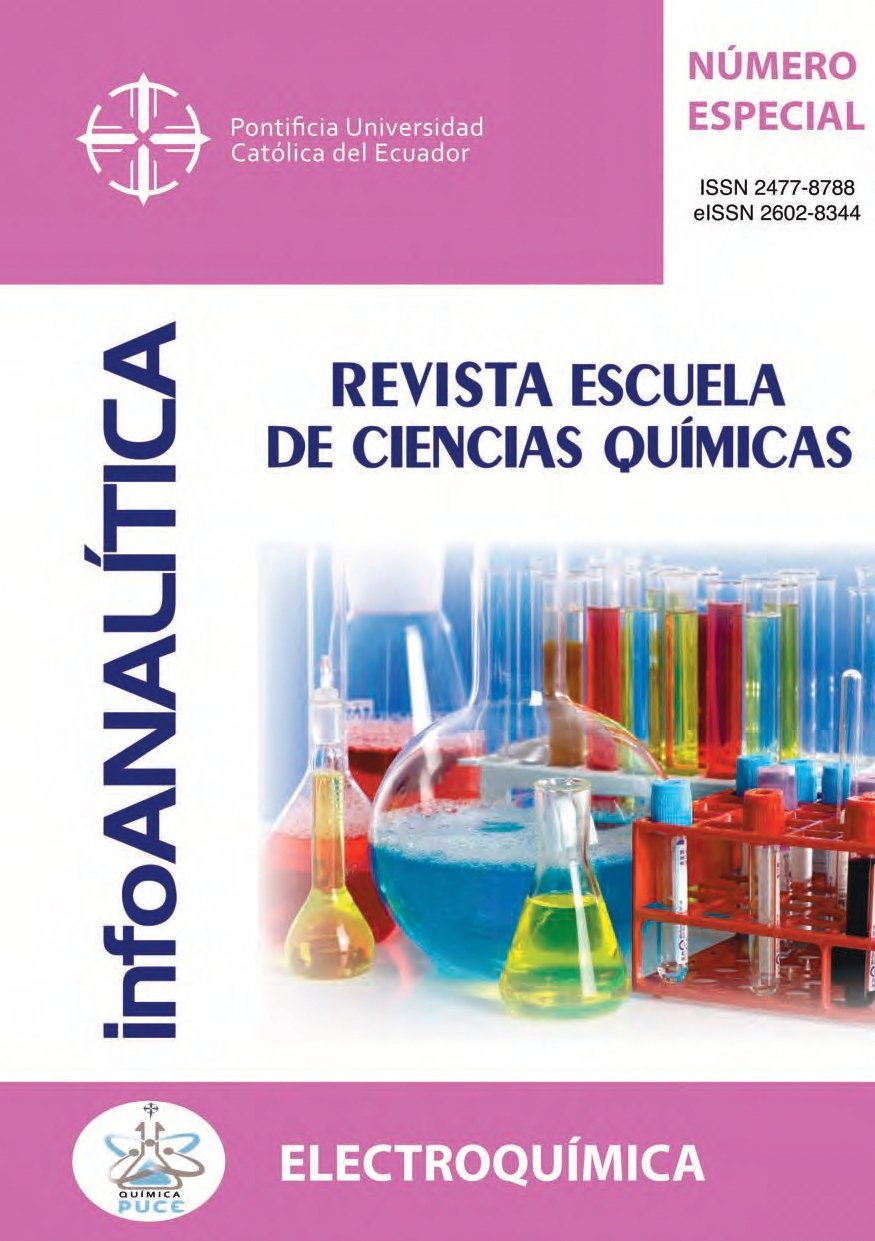Ajuste no lineal de técnicas electroquímicas
Contenido principal del artículo
Resumen
El análisis de datos experimentales mediante ajuste no lineal es poco común, quizá una de las causas es que se requiere de programas especializados con licencias como Zview® o DigiElch. Para la determinación de parámetros cinéticos, termodinámicos de un sistema redox y de una celda en estudio, se usan técnicas electroquímicas. El ajuste no lineal de técnicas electroquímicas como voltamperometría cíclica y cronoamperometría se puede realizar en una hoja de cálculo de Microsoft Excel empleando el complemento Solver. En este artículo se utilizó el programa Solver para ajustar registros electroquímicos experimentales presentando dos ejemplos donde se determinaron los valores del área de un electrodo de oro y la constante heterogénea de transferencia electrónica estándar del hexacianoferrato(III) de potasio sobre un ultramicroelectrodo de platino.
Descargas
Detalles del artículo
- Los autores se comprometen a respetar la información académica de otros autores, y a ceder los derechos de autor a la Revista infoANALÍTICA, para que el artículo pueda ser editado, publicado y distribuido.
- El contenido de los artículos científicos y de las publicaciones que aparecen en la revista es responsabilidad exclusiva de sus autores. La distribución de los artículos publicados en la Revista infoANALÍTICA se realiza bajo una licencia Creative Commons Reconocimiento-CompartirIgual 4.0 Internacional License.
Citas
Metals by flame atomic absorption spectrometry (2018). In Standard Methods For the Examination of Water and Wastewater. American Public Health Association. https://doi.org/doi:10.2105/SMWW.2882.043
-N nitrogen (2018). In Standard Methods For the Examination of Water and Wastewater. American Public Health Association. https://doi.org/doi:10.2105/SMWW.2882.086
-P phosphorus (2018). In Standard Methods For the Examination of Water and Wastewater. American Public Health Association. https://doi.org/doi:10.2105/ SMWW.2882.093
chemical oxygen demand (COD) (2018). In Standard Methods For the Examination of Water and wastewater. American Public Health Association. https://doi.org/doi:10.2105/SMWW.2882.103
Aelterman, P., Rabaey, K., Clauwaert, P., & Verstraete, W. (2006). Microbial fuel cells for wastewater treatment. Water Science and Technology, 54(8), 9–15. https://doi.org/10.2166/wst.2006.702
Bassante, N. (2018). Evaluación del efecto de polímeros conductores en el tratamieno de aguas residuales domésticas utilizando celdas de combustible microbianas. Universidad Central del Ecuador.
Behera, M., & Ghangrekar, M. M. (2011). Electricity generation in low cost microbial fuel cell made up of earthenware of different thickness. Water Science and Technology, 64(12), 2468–2473. https://doi.org/10.2166/wst.2011.822
Buitrón, G., & Cervantes-Astorga, C. (2013). Performance evaluation of a low-cost microbial fuel cell using municipal wastewater. Water, Air, and Soil Pollution, 224(3). https://doi.org/10.1007/s11270-013-1470-z
Choi, S. (2015). Microscale microbial fuel cells: Advances and challenges. Biosensors and Bioelectronics, 69, 8–25. https://doi.org/10.1016/j.bios.2015.02.021
Do, M. H., Ngo, H. H., Guo, W. S., Liu, Y., Chang, S. W., Nguyen, D. D., Nghiem, L. D., & Ni, B. J. (2018). Challenges in the application of microbial fuel cells to wastewater treatment and energy production: A mini review. Science of the Total Environment, 639, 910–920. https://doi.org/10.1016/j.scitotenv.2018.05.136
Geissdoerfer, M., Savaget, P., Bocken, N. M. P., & Hultink, E. J. (2017). The Circular Economy – A new sustainability paradigm? Journal of Cleaner Production, 143, 757–768. https://doi.org/https://doi.org/10.1016/j.jclepro.2016.12.048
Hernandez-Fernandez, F. J., de Los Rios, A. P., Salar-Garcia, M. J., Ortiz-Martinez, V. M., Lozano-Blanco, L. J., Godinez, C., Tomas-Alonso, F., & Quesada-Medina, J. (2015). Recent progress and perspectives in microbial fuel cells for bioenergy generation and wastewater treatment. Fuel Processing Technology, 138, 284–297. https://doi.org/10.1016/j.fuproc.2015.05.022
Li, M., Zhou, M., Tian, X., Tan, C., Cameron, T., Hassett, D. J., & Gu, T. (2018). Microbial fuel cell (MFC) power performance improvement through enhanced microbial electrogenicity Ming. Biotechnology Advances, December 2017, #pagerange#. https://doi.org/10.1016/j.biotechadv.2018.04.010
Logan, B. E. (2007). Microbial Fuel Cells. John Wiley & Sons, Inc. https://doi.org/ 10.1002/
Logan, B. E., Hamelers, B., Rozendal, R., Schröder, U., Keller, J., Freguia, S., Aelterman, P., Verstraete, W., & Rabaey, K. (2006). Microbial fuel cells: Methodology and technology. Environmental Science and Technology, 40(17), 5181–5192. https://doi.org/10.1021/es0605016
Logan, B. E., & Rabaey, K. (2012). Conversion of wastes into bioelectricity and chemicals by using microbial electrochemical technologies. Science, 337(6095), 686–690. https://doi.org/10.1126/science.1217412
Rabaey, K., & Verstraete, W. (2005). Microbial fuel cells: Novel biotechnology for energy generation. Trends in Biotechnology, 23(6), 291–298. https://doi.org/10.1016/j.tibtech.2005.04.008
Rea, H. S. (2017). Evaluación de la biomasa producida por el tratamiento de aguas residuales domésticas usando celdas de combustible microbiano (MFCs) como posible abono agricola. Universidad Central del Ecuador.
Sacco, N. J., Figuerola, E. L. M., Pataccini, G., Bonetto, M. C., Erijman, L., & Cortón, E. (2012). Performance of planar and cylindrical carbon electrodes at sedimentary microbial fuel cells. Bioresource Technology, 126, 328–335. https://doi.org/https://doi.org/10.1016/j.biortech.2012.09.060
Sivasankar, V., Mylsamy, P., & Omine, K. (Eds.). (2018). Microbial Fuel Cell Technology for Bioelectricity. Springer International Publishing. https://doi.org/10.1007/978-3-319-92904-0
Wei, B., Tokash, J. C., Chen, G., Hickner, M. A., & Logan, B. E. (2012). Development and evaluation of carbon and binder loading in low-cost activated carbon cathodes for air-cathode microbial fuel cells. RSC Advances, 2(33), 12751–12758. https://doi.org/10.1039/C2RA21572A
Zhang, F., Cheng, S., Pant, D., Bogaert, G. Van, & Logan, B. E. (2009). Power generation using an activated carbon and metal mesh cathode in a microbial fuel cell. Electrochemistry Communications, 11(11), 2177–2179. https://doi.org/https://doi.org/10.1016/j.elecom.2009.09.024

